HRM Report: Recruitment, Retention, and Talent Management Analysis
VerifiedAdded on 2021/04/17
|18
|4659
|36
Report
AI Summary
This report delves into the critical aspects of Human Resource Management (HRM), specifically focusing on recruitment, selection, employee retention, and talent management. The report begins by highlighting the importance of HRM in ensuring organizational success through effective recruitment and the creation of a positive working environment to retain employees. It then explores the recruitment and selection processes, including strategies like website adverts, recruitment portals, and employee referrals, while also considering the influence of factors like attrition rates and job market dynamics. The report also examines employee retention and talent management, discussing reasons for low retention and various strategies to improve employee retention rates. Overall, this report provides a comprehensive overview of HRM practices, offering insights into the challenges and strategies associated with managing human resources effectively.
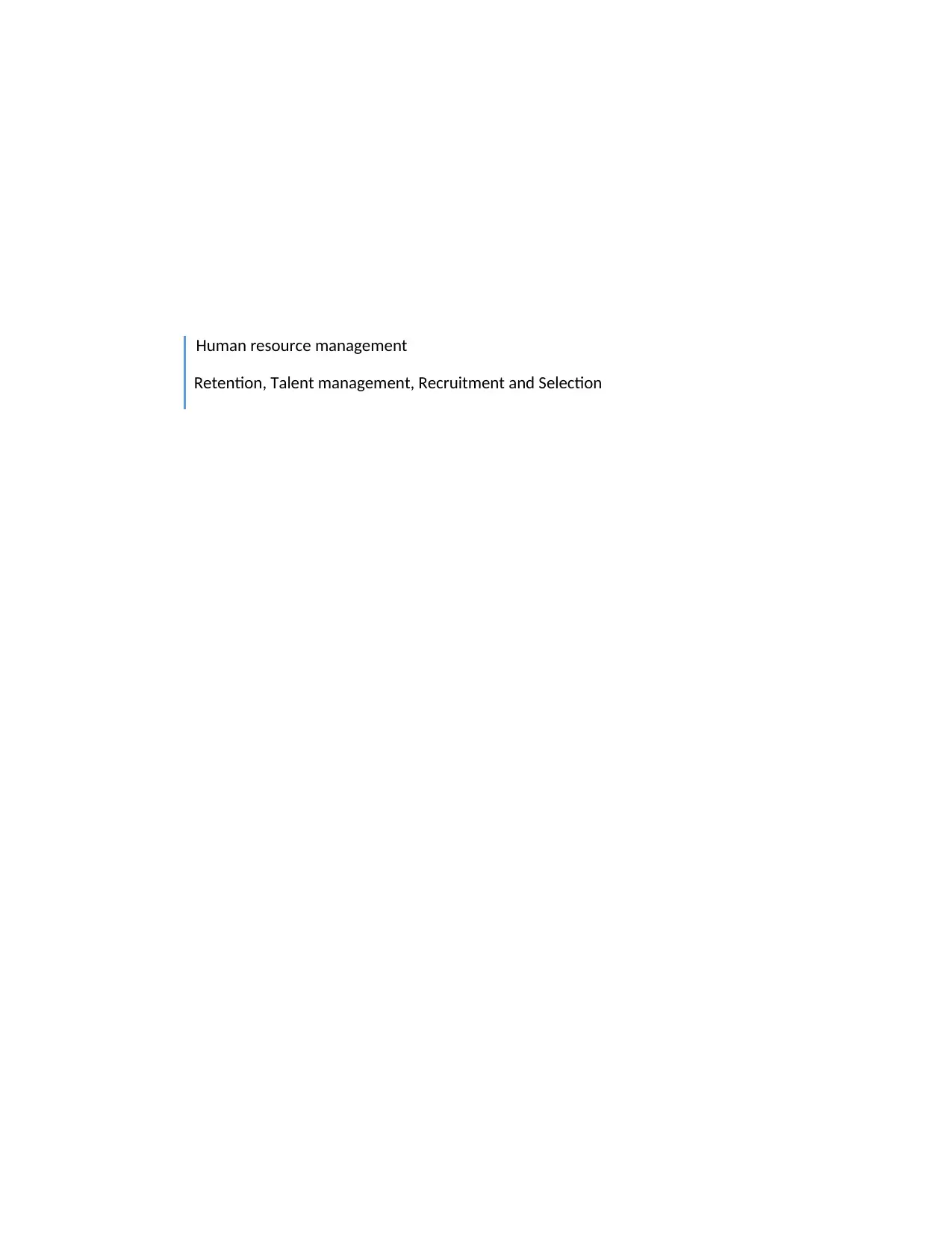
Human resource management
Retention, Talent management, Recruitment and Selection
Retention, Talent management, Recruitment and Selection
Paraphrase This Document
Need a fresh take? Get an instant paraphrase of this document with our AI Paraphraser
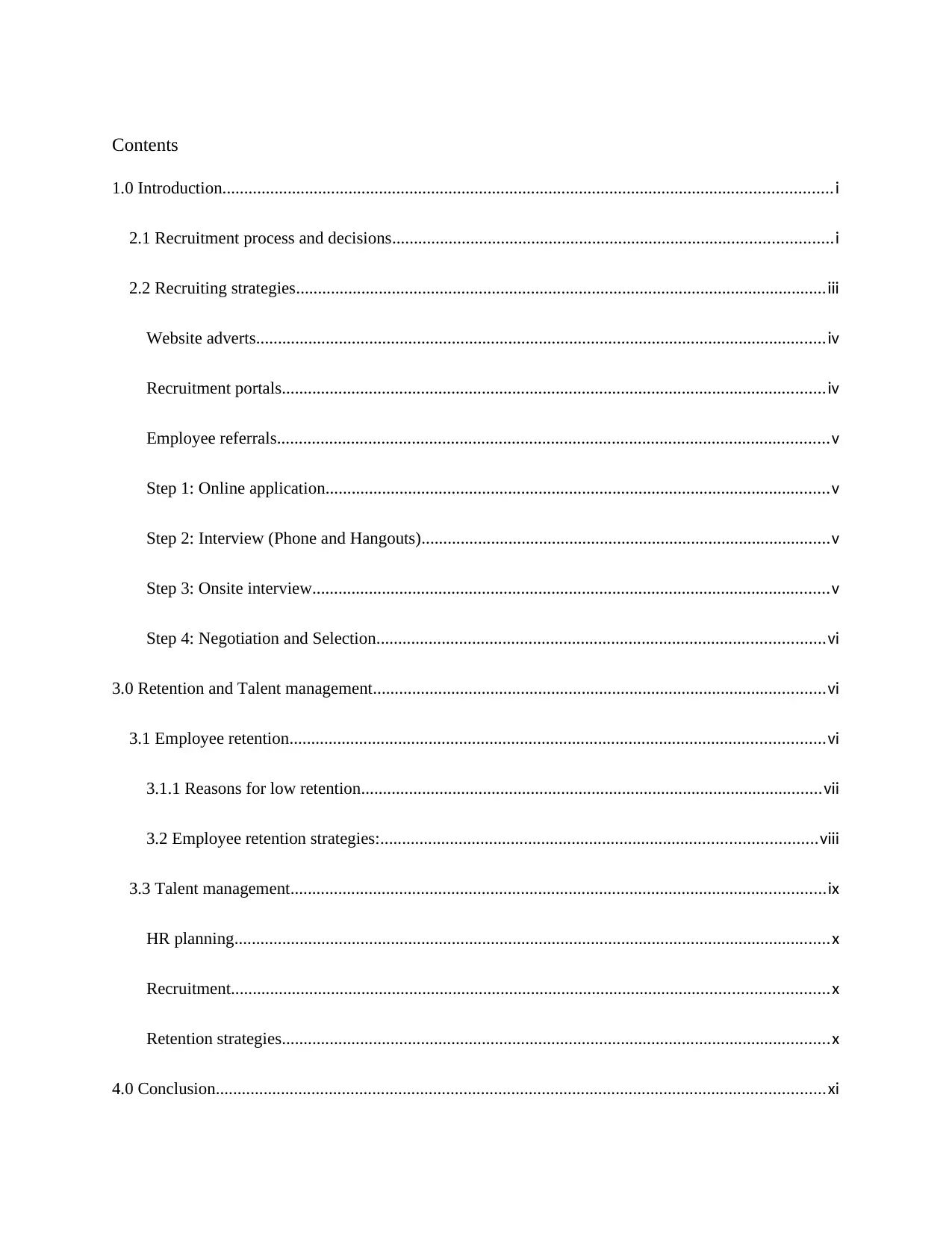
Contents
1.0 Introduction............................................................................................................................................i
2.1 Recruitment process and decisions.....................................................................................................i
2.2 Recruiting strategies..........................................................................................................................iii
Website adverts...................................................................................................................................iv
Recruitment portals.............................................................................................................................iv
Employee referrals...............................................................................................................................v
Step 1: Online application....................................................................................................................v
Step 2: Interview (Phone and Hangouts)..............................................................................................v
Step 3: Onsite interview.......................................................................................................................v
Step 4: Negotiation and Selection.......................................................................................................vi
3.0 Retention and Talent management........................................................................................................vi
3.1 Employee retention...........................................................................................................................vi
3.1.1 Reasons for low retention..........................................................................................................vii
3.2 Employee retention strategies:....................................................................................................viii
3.3 Talent management...........................................................................................................................ix
HR planning.........................................................................................................................................x
Recruitment.........................................................................................................................................x
Retention strategies..............................................................................................................................x
4.0 Conclusion............................................................................................................................................xi
1.0 Introduction............................................................................................................................................i
2.1 Recruitment process and decisions.....................................................................................................i
2.2 Recruiting strategies..........................................................................................................................iii
Website adverts...................................................................................................................................iv
Recruitment portals.............................................................................................................................iv
Employee referrals...............................................................................................................................v
Step 1: Online application....................................................................................................................v
Step 2: Interview (Phone and Hangouts)..............................................................................................v
Step 3: Onsite interview.......................................................................................................................v
Step 4: Negotiation and Selection.......................................................................................................vi
3.0 Retention and Talent management........................................................................................................vi
3.1 Employee retention...........................................................................................................................vi
3.1.1 Reasons for low retention..........................................................................................................vii
3.2 Employee retention strategies:....................................................................................................viii
3.3 Talent management...........................................................................................................................ix
HR planning.........................................................................................................................................x
Recruitment.........................................................................................................................................x
Retention strategies..............................................................................................................................x
4.0 Conclusion............................................................................................................................................xi

5.0 References............................................................................................................................................xii
⊘ This is a preview!⊘
Do you want full access?
Subscribe today to unlock all pages.

Trusted by 1+ million students worldwide

i
1.0 Introduction
Human Resource Management is a crucial aspect of any organization. HRM performs a sundry
set of functions within the business and helps businesses in managing the organization’s most
valued assets. An effective HRM ensures efficient recruitment of employees, timely training and
development, transparent communication in the business, fair compensation for employees and
expeditious addressing of employee grievances. Human Resource Management has achieved
significant importance in the last few years: In practice as well as in literature (Brewster &
Hegewisch, 2017).
This report throws light on two vital roles played by the HRM viz-a-viz recruitment & selection
as well as employee retention and talent management. Ensuring that the organization is equipped
with the right people at the right time is very pivotal for the success of the business. HRM
ensures that competent people are hired in the business through a transparent and highly effective
process (Board, 2017). Once the employees institute tenure, it becomes the responsibility of the
HRM to create a positive working environment for employees to remain associated with the
business for a long term. This is where talent management comes into the picture and fortifies
that at any given point of time an adequate number of people are associated with the business
(Armstrong & Taylor, 2014).
2.0 Recruitment and Selection
Effective recruitment and selection are pivotal to the success of any business. These two process
combines ultimately determine the quality of the employees in an organization (Costen, 2012).
Managing human resources of the organization begins at bringing in the right employees for the
right job profile in the business. Recruitment includes the process of bringing competent and
interested candidates to apply for the jobs available in the organization. On the other hand,
Selection refers to the process that these candidates undergo before being finalized for the
position. Organizations need to respond to rapidly changing global environment. Continued
success is, thus, dependent on attracting and retaining high quality individuals who can respond
effectively to this changing environment (Newel, 2015).
1.0 Introduction
Human Resource Management is a crucial aspect of any organization. HRM performs a sundry
set of functions within the business and helps businesses in managing the organization’s most
valued assets. An effective HRM ensures efficient recruitment of employees, timely training and
development, transparent communication in the business, fair compensation for employees and
expeditious addressing of employee grievances. Human Resource Management has achieved
significant importance in the last few years: In practice as well as in literature (Brewster &
Hegewisch, 2017).
This report throws light on two vital roles played by the HRM viz-a-viz recruitment & selection
as well as employee retention and talent management. Ensuring that the organization is equipped
with the right people at the right time is very pivotal for the success of the business. HRM
ensures that competent people are hired in the business through a transparent and highly effective
process (Board, 2017). Once the employees institute tenure, it becomes the responsibility of the
HRM to create a positive working environment for employees to remain associated with the
business for a long term. This is where talent management comes into the picture and fortifies
that at any given point of time an adequate number of people are associated with the business
(Armstrong & Taylor, 2014).
2.0 Recruitment and Selection
Effective recruitment and selection are pivotal to the success of any business. These two process
combines ultimately determine the quality of the employees in an organization (Costen, 2012).
Managing human resources of the organization begins at bringing in the right employees for the
right job profile in the business. Recruitment includes the process of bringing competent and
interested candidates to apply for the jobs available in the organization. On the other hand,
Selection refers to the process that these candidates undergo before being finalized for the
position. Organizations need to respond to rapidly changing global environment. Continued
success is, thus, dependent on attracting and retaining high quality individuals who can respond
effectively to this changing environment (Newel, 2015).
Paraphrase This Document
Need a fresh take? Get an instant paraphrase of this document with our AI Paraphraser

2.1 Recruitment process and decisions
Recruitment involves the process of attracting the interest of a pool of capable people who will
apply for jobs within the organization (Bratton & Gold, 2017). It is a core function of Human
Resource Management. Recruitment process ideally begins with identifying a gap between the
HR needs of a business and the current workforce employed by the business. Once the gap has
been identified, businesses attract candidates through a variety of sources and make those
candidates go through a selection procedure.
Recruitment plays a vital role as businesses tend to understand its manpower recruitment and
competent candidates seek jobs. Effective recruitment processes are not just necessary for the
business but for the growth of the economy. Malaysian unemployment rate stands at 3.4% this
January (Trading Economics, 2018). On the other hand job vacancies in the country slumped to
401835 in the last quarter of 2017. There is a 2% rise in the labor force in 2017 as compared to
2016, yet there is an increasing need to work upon employee dissatisfaction (Department of
Statistics Malaysia, 2018). This could be due to decreasing job satisfaction and lowering growth
opportunities. Average salary increase rate in Malaysia declined to 5% in 2017 (New Straits
Times, 2018). These statistics are evident that there is an increasing need for Malaysian
organizations to improvise the recruitment process in order to be able to attract new talent in the
business.
Recruitment process at all the organizations varies slightly on the bases of organizations attrition
rate, size of the organization as well as nature of the business. Large organizations like Dell have
a large pool of candidates who have shown interest in working for the firm. The goodwill and
effective positioning of these organizations automatically attracts candidates to work with these
firms. On the other hand, small organizations or Startups like ‘Food Matters’ need to put
additional efforts in attracting potential candidates. Therefore, these organizations resort to
various recruitment strategies discussed in the next part of the report.
Dell also supports internal recruitment because of the large number of employees working with
the business. The organization posts job requirements on the company website as well as ties up
with online job portals in order to attract competent candidates (Dell EMC, 2018). While on the
Recruitment involves the process of attracting the interest of a pool of capable people who will
apply for jobs within the organization (Bratton & Gold, 2017). It is a core function of Human
Resource Management. Recruitment process ideally begins with identifying a gap between the
HR needs of a business and the current workforce employed by the business. Once the gap has
been identified, businesses attract candidates through a variety of sources and make those
candidates go through a selection procedure.
Recruitment plays a vital role as businesses tend to understand its manpower recruitment and
competent candidates seek jobs. Effective recruitment processes are not just necessary for the
business but for the growth of the economy. Malaysian unemployment rate stands at 3.4% this
January (Trading Economics, 2018). On the other hand job vacancies in the country slumped to
401835 in the last quarter of 2017. There is a 2% rise in the labor force in 2017 as compared to
2016, yet there is an increasing need to work upon employee dissatisfaction (Department of
Statistics Malaysia, 2018). This could be due to decreasing job satisfaction and lowering growth
opportunities. Average salary increase rate in Malaysia declined to 5% in 2017 (New Straits
Times, 2018). These statistics are evident that there is an increasing need for Malaysian
organizations to improvise the recruitment process in order to be able to attract new talent in the
business.
Recruitment process at all the organizations varies slightly on the bases of organizations attrition
rate, size of the organization as well as nature of the business. Large organizations like Dell have
a large pool of candidates who have shown interest in working for the firm. The goodwill and
effective positioning of these organizations automatically attracts candidates to work with these
firms. On the other hand, small organizations or Startups like ‘Food Matters’ need to put
additional efforts in attracting potential candidates. Therefore, these organizations resort to
various recruitment strategies discussed in the next part of the report.
Dell also supports internal recruitment because of the large number of employees working with
the business. The organization posts job requirements on the company website as well as ties up
with online job portals in order to attract competent candidates (Dell EMC, 2018). While on the
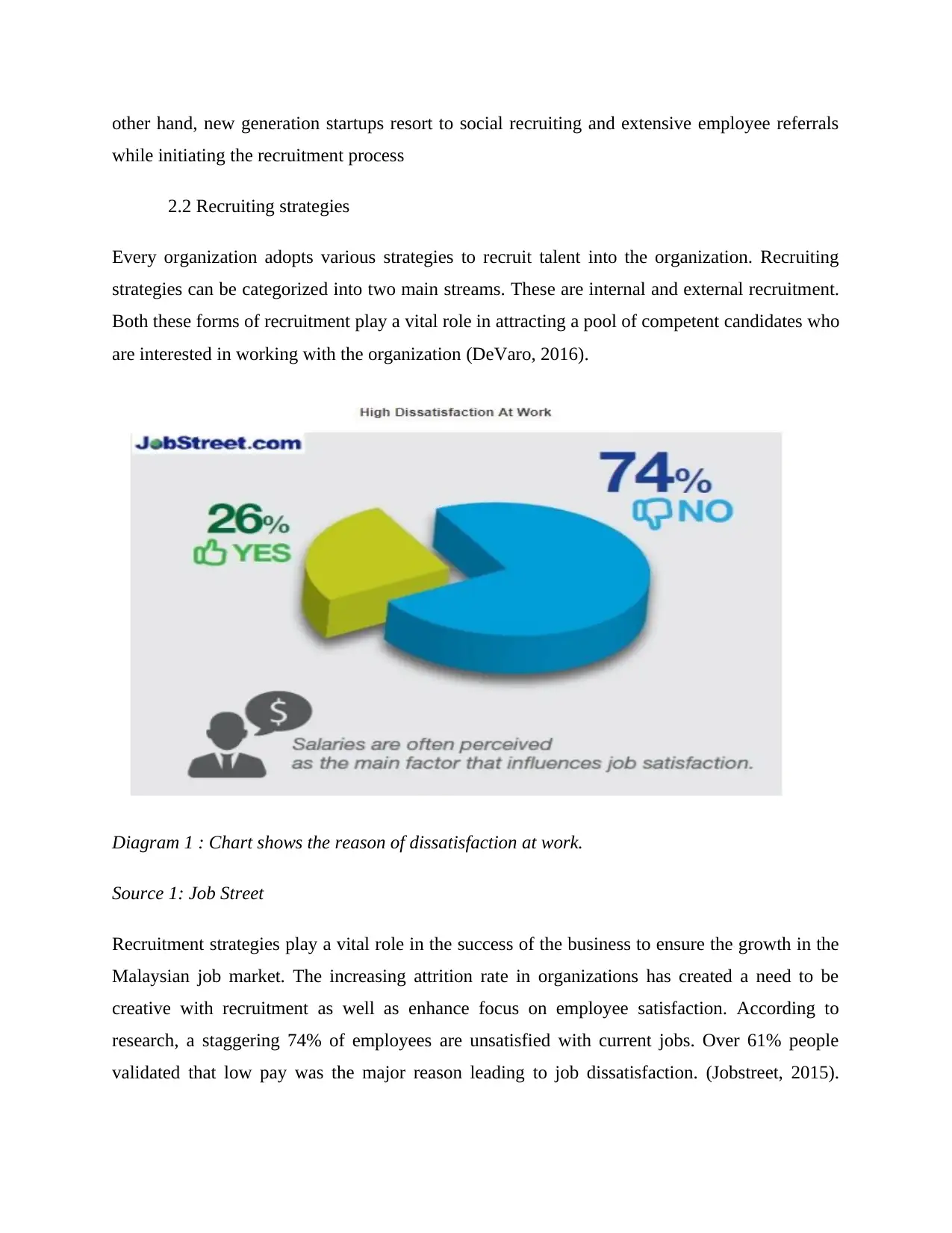
other hand, new generation startups resort to social recruiting and extensive employee referrals
while initiating the recruitment process
2.2 Recruiting strategies
Every organization adopts various strategies to recruit talent into the organization. Recruiting
strategies can be categorized into two main streams. These are internal and external recruitment.
Both these forms of recruitment play a vital role in attracting a pool of competent candidates who
are interested in working with the organization (DeVaro, 2016).
Diagram 1 : Chart shows the reason of dissatisfaction at work.
Source 1: Job Street
Recruitment strategies play a vital role in the success of the business to ensure the growth in the
Malaysian job market. The increasing attrition rate in organizations has created a need to be
creative with recruitment as well as enhance focus on employee satisfaction. According to
research, a staggering 74% of employees are unsatisfied with current jobs. Over 61% people
validated that low pay was the major reason leading to job dissatisfaction. (Jobstreet, 2015).
while initiating the recruitment process
2.2 Recruiting strategies
Every organization adopts various strategies to recruit talent into the organization. Recruiting
strategies can be categorized into two main streams. These are internal and external recruitment.
Both these forms of recruitment play a vital role in attracting a pool of competent candidates who
are interested in working with the organization (DeVaro, 2016).
Diagram 1 : Chart shows the reason of dissatisfaction at work.
Source 1: Job Street
Recruitment strategies play a vital role in the success of the business to ensure the growth in the
Malaysian job market. The increasing attrition rate in organizations has created a need to be
creative with recruitment as well as enhance focus on employee satisfaction. According to
research, a staggering 74% of employees are unsatisfied with current jobs. Over 61% people
validated that low pay was the major reason leading to job dissatisfaction. (Jobstreet, 2015).
⊘ This is a preview!⊘
Do you want full access?
Subscribe today to unlock all pages.

Trusted by 1+ million students worldwide
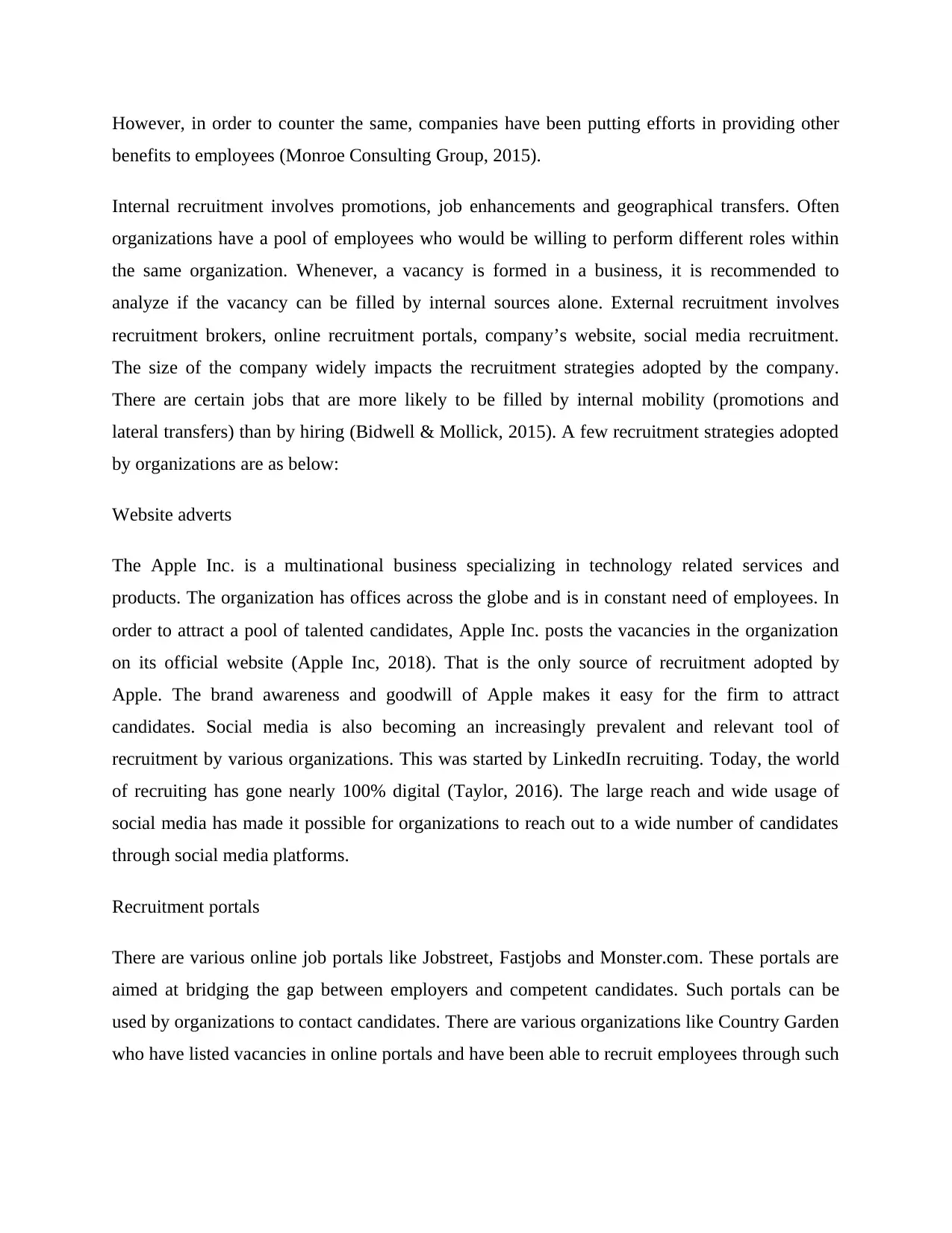
However, in order to counter the same, companies have been putting efforts in providing other
benefits to employees (Monroe Consulting Group, 2015).
Internal recruitment involves promotions, job enhancements and geographical transfers. Often
organizations have a pool of employees who would be willing to perform different roles within
the same organization. Whenever, a vacancy is formed in a business, it is recommended to
analyze if the vacancy can be filled by internal sources alone. External recruitment involves
recruitment brokers, online recruitment portals, company’s website, social media recruitment.
The size of the company widely impacts the recruitment strategies adopted by the company.
There are certain jobs that are more likely to be filled by internal mobility (promotions and
lateral transfers) than by hiring (Bidwell & Mollick, 2015). A few recruitment strategies adopted
by organizations are as below:
Website adverts
The Apple Inc. is a multinational business specializing in technology related services and
products. The organization has offices across the globe and is in constant need of employees. In
order to attract a pool of talented candidates, Apple Inc. posts the vacancies in the organization
on its official website (Apple Inc, 2018). That is the only source of recruitment adopted by
Apple. The brand awareness and goodwill of Apple makes it easy for the firm to attract
candidates. Social media is also becoming an increasingly prevalent and relevant tool of
recruitment by various organizations. This was started by LinkedIn recruiting. Today, the world
of recruiting has gone nearly 100% digital (Taylor, 2016). The large reach and wide usage of
social media has made it possible for organizations to reach out to a wide number of candidates
through social media platforms.
Recruitment portals
There are various online job portals like Jobstreet, Fastjobs and Monster.com. These portals are
aimed at bridging the gap between employers and competent candidates. Such portals can be
used by organizations to contact candidates. There are various organizations like Country Garden
who have listed vacancies in online portals and have been able to recruit employees through such
benefits to employees (Monroe Consulting Group, 2015).
Internal recruitment involves promotions, job enhancements and geographical transfers. Often
organizations have a pool of employees who would be willing to perform different roles within
the same organization. Whenever, a vacancy is formed in a business, it is recommended to
analyze if the vacancy can be filled by internal sources alone. External recruitment involves
recruitment brokers, online recruitment portals, company’s website, social media recruitment.
The size of the company widely impacts the recruitment strategies adopted by the company.
There are certain jobs that are more likely to be filled by internal mobility (promotions and
lateral transfers) than by hiring (Bidwell & Mollick, 2015). A few recruitment strategies adopted
by organizations are as below:
Website adverts
The Apple Inc. is a multinational business specializing in technology related services and
products. The organization has offices across the globe and is in constant need of employees. In
order to attract a pool of talented candidates, Apple Inc. posts the vacancies in the organization
on its official website (Apple Inc, 2018). That is the only source of recruitment adopted by
Apple. The brand awareness and goodwill of Apple makes it easy for the firm to attract
candidates. Social media is also becoming an increasingly prevalent and relevant tool of
recruitment by various organizations. This was started by LinkedIn recruiting. Today, the world
of recruiting has gone nearly 100% digital (Taylor, 2016). The large reach and wide usage of
social media has made it possible for organizations to reach out to a wide number of candidates
through social media platforms.
Recruitment portals
There are various online job portals like Jobstreet, Fastjobs and Monster.com. These portals are
aimed at bridging the gap between employers and competent candidates. Such portals can be
used by organizations to contact candidates. There are various organizations like Country Garden
who have listed vacancies in online portals and have been able to recruit employees through such
Paraphrase This Document
Need a fresh take? Get an instant paraphrase of this document with our AI Paraphraser
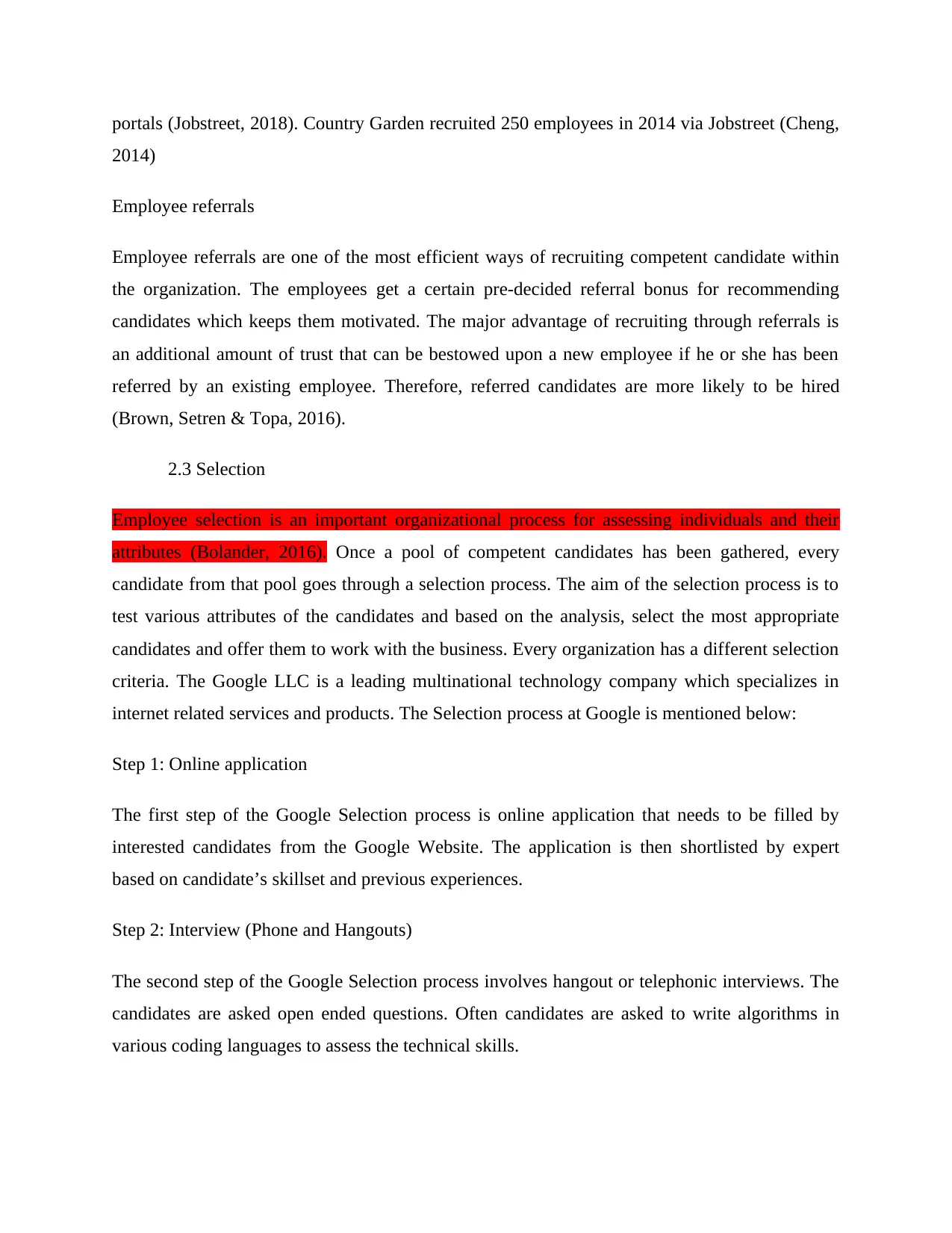
portals (Jobstreet, 2018). Country Garden recruited 250 employees in 2014 via Jobstreet (Cheng,
2014)
Employee referrals
Employee referrals are one of the most efficient ways of recruiting competent candidate within
the organization. The employees get a certain pre-decided referral bonus for recommending
candidates which keeps them motivated. The major advantage of recruiting through referrals is
an additional amount of trust that can be bestowed upon a new employee if he or she has been
referred by an existing employee. Therefore, referred candidates are more likely to be hired
(Brown, Setren & Topa, 2016).
2.3 Selection
Employee selection is an important organizational process for assessing individuals and their
attributes (Bolander, 2016). Once a pool of competent candidates has been gathered, every
candidate from that pool goes through a selection process. The aim of the selection process is to
test various attributes of the candidates and based on the analysis, select the most appropriate
candidates and offer them to work with the business. Every organization has a different selection
criteria. The Google LLC is a leading multinational technology company which specializes in
internet related services and products. The Selection process at Google is mentioned below:
Step 1: Online application
The first step of the Google Selection process is online application that needs to be filled by
interested candidates from the Google Website. The application is then shortlisted by expert
based on candidate’s skillset and previous experiences.
Step 2: Interview (Phone and Hangouts)
The second step of the Google Selection process involves hangout or telephonic interviews. The
candidates are asked open ended questions. Often candidates are asked to write algorithms in
various coding languages to assess the technical skills.
2014)
Employee referrals
Employee referrals are one of the most efficient ways of recruiting competent candidate within
the organization. The employees get a certain pre-decided referral bonus for recommending
candidates which keeps them motivated. The major advantage of recruiting through referrals is
an additional amount of trust that can be bestowed upon a new employee if he or she has been
referred by an existing employee. Therefore, referred candidates are more likely to be hired
(Brown, Setren & Topa, 2016).
2.3 Selection
Employee selection is an important organizational process for assessing individuals and their
attributes (Bolander, 2016). Once a pool of competent candidates has been gathered, every
candidate from that pool goes through a selection process. The aim of the selection process is to
test various attributes of the candidates and based on the analysis, select the most appropriate
candidates and offer them to work with the business. Every organization has a different selection
criteria. The Google LLC is a leading multinational technology company which specializes in
internet related services and products. The Selection process at Google is mentioned below:
Step 1: Online application
The first step of the Google Selection process is online application that needs to be filled by
interested candidates from the Google Website. The application is then shortlisted by expert
based on candidate’s skillset and previous experiences.
Step 2: Interview (Phone and Hangouts)
The second step of the Google Selection process involves hangout or telephonic interviews. The
candidates are asked open ended questions. Often candidates are asked to write algorithms in
various coding languages to assess the technical skills.
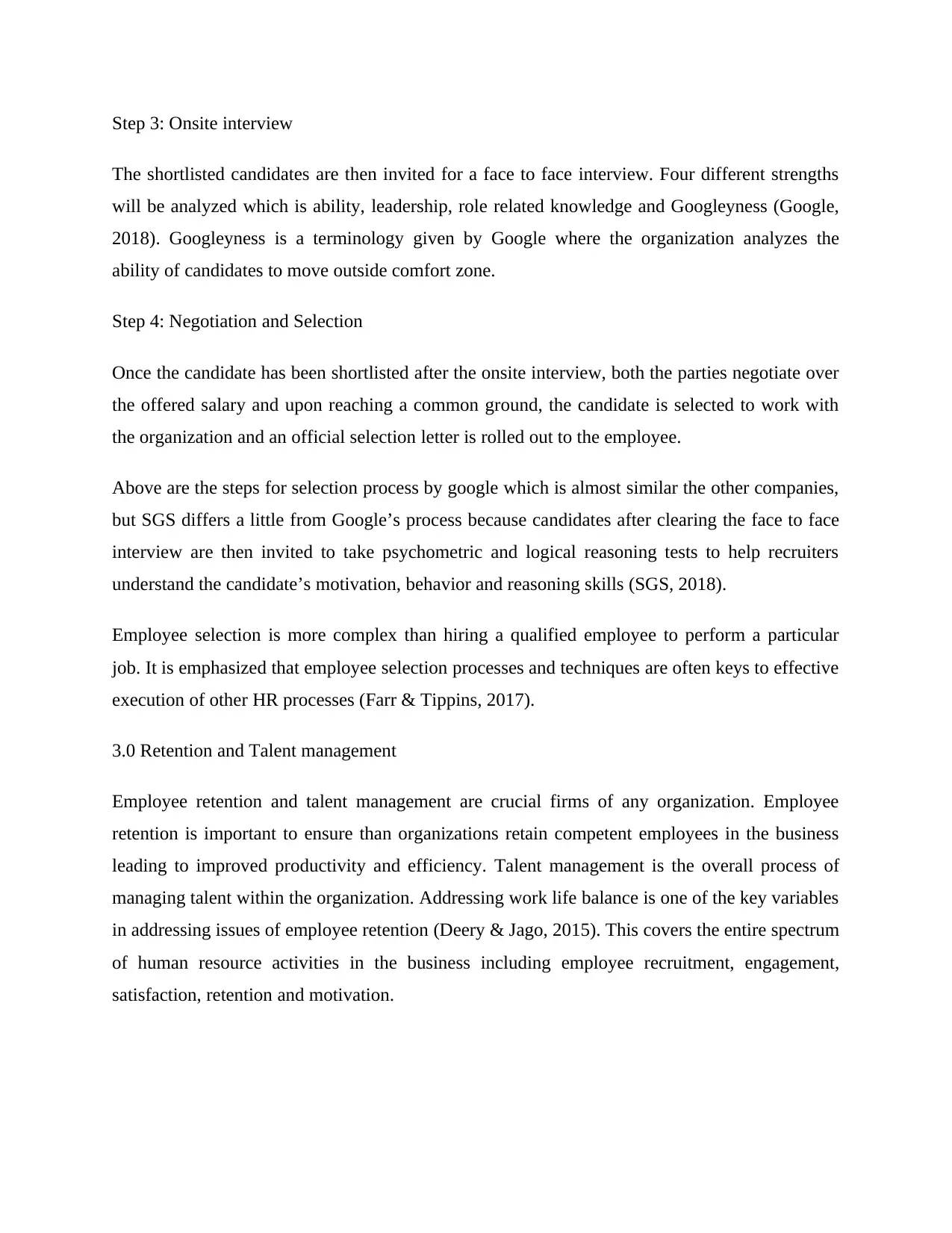
Step 3: Onsite interview
The shortlisted candidates are then invited for a face to face interview. Four different strengths
will be analyzed which is ability, leadership, role related knowledge and Googleyness (Google,
2018). Googleyness is a terminology given by Google where the organization analyzes the
ability of candidates to move outside comfort zone.
Step 4: Negotiation and Selection
Once the candidate has been shortlisted after the onsite interview, both the parties negotiate over
the offered salary and upon reaching a common ground, the candidate is selected to work with
the organization and an official selection letter is rolled out to the employee.
Above are the steps for selection process by google which is almost similar the other companies,
but SGS differs a little from Google’s process because candidates after clearing the face to face
interview are then invited to take psychometric and logical reasoning tests to help recruiters
understand the candidate’s motivation, behavior and reasoning skills (SGS, 2018).
Employee selection is more complex than hiring a qualified employee to perform a particular
job. It is emphasized that employee selection processes and techniques are often keys to effective
execution of other HR processes (Farr & Tippins, 2017).
3.0 Retention and Talent management
Employee retention and talent management are crucial firms of any organization. Employee
retention is important to ensure than organizations retain competent employees in the business
leading to improved productivity and efficiency. Talent management is the overall process of
managing talent within the organization. Addressing work life balance is one of the key variables
in addressing issues of employee retention (Deery & Jago, 2015). This covers the entire spectrum
of human resource activities in the business including employee recruitment, engagement,
satisfaction, retention and motivation.
The shortlisted candidates are then invited for a face to face interview. Four different strengths
will be analyzed which is ability, leadership, role related knowledge and Googleyness (Google,
2018). Googleyness is a terminology given by Google where the organization analyzes the
ability of candidates to move outside comfort zone.
Step 4: Negotiation and Selection
Once the candidate has been shortlisted after the onsite interview, both the parties negotiate over
the offered salary and upon reaching a common ground, the candidate is selected to work with
the organization and an official selection letter is rolled out to the employee.
Above are the steps for selection process by google which is almost similar the other companies,
but SGS differs a little from Google’s process because candidates after clearing the face to face
interview are then invited to take psychometric and logical reasoning tests to help recruiters
understand the candidate’s motivation, behavior and reasoning skills (SGS, 2018).
Employee selection is more complex than hiring a qualified employee to perform a particular
job. It is emphasized that employee selection processes and techniques are often keys to effective
execution of other HR processes (Farr & Tippins, 2017).
3.0 Retention and Talent management
Employee retention and talent management are crucial firms of any organization. Employee
retention is important to ensure than organizations retain competent employees in the business
leading to improved productivity and efficiency. Talent management is the overall process of
managing talent within the organization. Addressing work life balance is one of the key variables
in addressing issues of employee retention (Deery & Jago, 2015). This covers the entire spectrum
of human resource activities in the business including employee recruitment, engagement,
satisfaction, retention and motivation.
⊘ This is a preview!⊘
Do you want full access?
Subscribe today to unlock all pages.

Trusted by 1+ million students worldwide
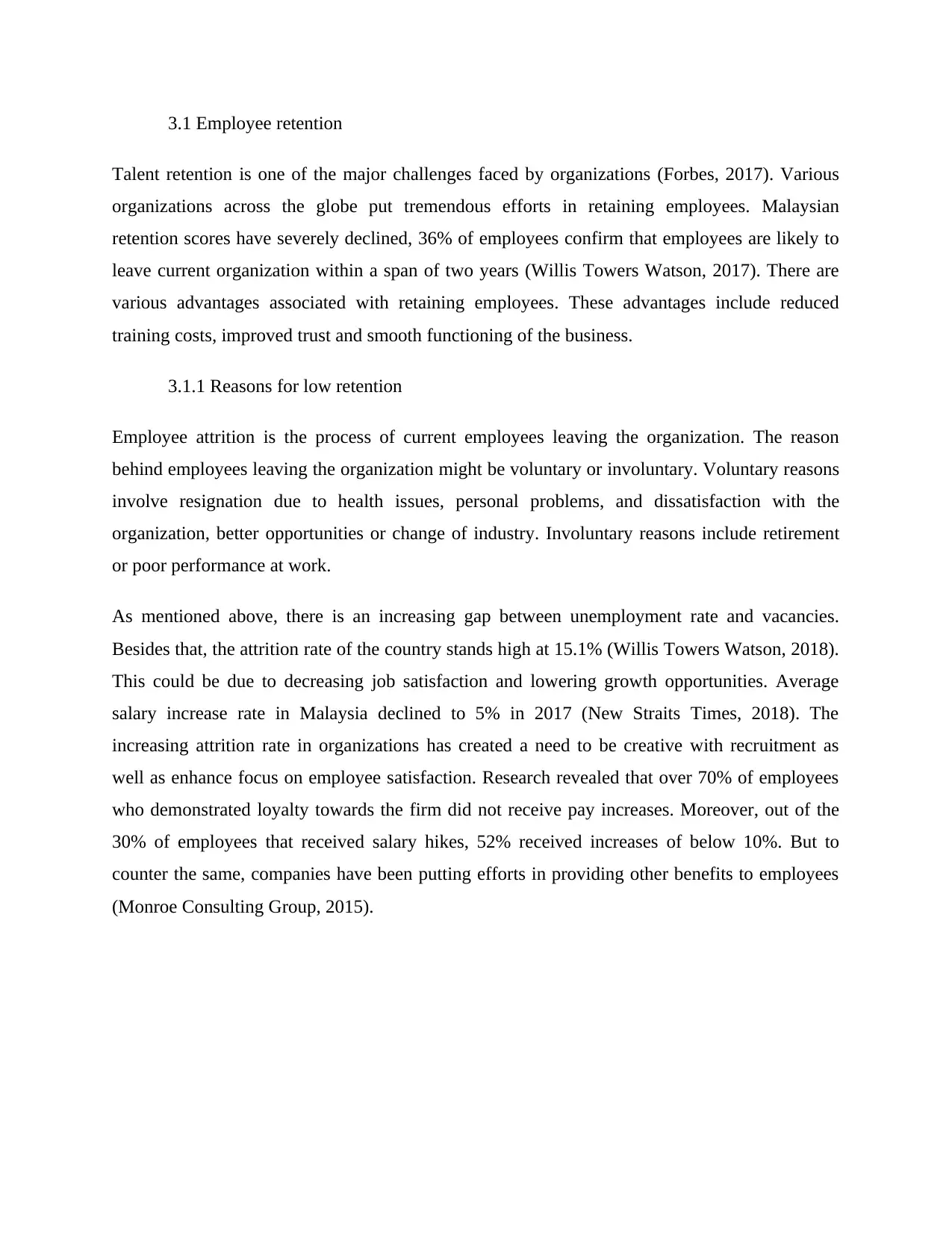
3.1 Employee retention
Talent retention is one of the major challenges faced by organizations (Forbes, 2017). Various
organizations across the globe put tremendous efforts in retaining employees. Malaysian
retention scores have severely declined, 36% of employees confirm that employees are likely to
leave current organization within a span of two years (Willis Towers Watson, 2017). There are
various advantages associated with retaining employees. These advantages include reduced
training costs, improved trust and smooth functioning of the business.
3.1.1 Reasons for low retention
Employee attrition is the process of current employees leaving the organization. The reason
behind employees leaving the organization might be voluntary or involuntary. Voluntary reasons
involve resignation due to health issues, personal problems, and dissatisfaction with the
organization, better opportunities or change of industry. Involuntary reasons include retirement
or poor performance at work.
As mentioned above, there is an increasing gap between unemployment rate and vacancies.
Besides that, the attrition rate of the country stands high at 15.1% (Willis Towers Watson, 2018).
This could be due to decreasing job satisfaction and lowering growth opportunities. Average
salary increase rate in Malaysia declined to 5% in 2017 (New Straits Times, 2018). The
increasing attrition rate in organizations has created a need to be creative with recruitment as
well as enhance focus on employee satisfaction. Research revealed that over 70% of employees
who demonstrated loyalty towards the firm did not receive pay increases. Moreover, out of the
30% of employees that received salary hikes, 52% received increases of below 10%. But to
counter the same, companies have been putting efforts in providing other benefits to employees
(Monroe Consulting Group, 2015).
Talent retention is one of the major challenges faced by organizations (Forbes, 2017). Various
organizations across the globe put tremendous efforts in retaining employees. Malaysian
retention scores have severely declined, 36% of employees confirm that employees are likely to
leave current organization within a span of two years (Willis Towers Watson, 2017). There are
various advantages associated with retaining employees. These advantages include reduced
training costs, improved trust and smooth functioning of the business.
3.1.1 Reasons for low retention
Employee attrition is the process of current employees leaving the organization. The reason
behind employees leaving the organization might be voluntary or involuntary. Voluntary reasons
involve resignation due to health issues, personal problems, and dissatisfaction with the
organization, better opportunities or change of industry. Involuntary reasons include retirement
or poor performance at work.
As mentioned above, there is an increasing gap between unemployment rate and vacancies.
Besides that, the attrition rate of the country stands high at 15.1% (Willis Towers Watson, 2018).
This could be due to decreasing job satisfaction and lowering growth opportunities. Average
salary increase rate in Malaysia declined to 5% in 2017 (New Straits Times, 2018). The
increasing attrition rate in organizations has created a need to be creative with recruitment as
well as enhance focus on employee satisfaction. Research revealed that over 70% of employees
who demonstrated loyalty towards the firm did not receive pay increases. Moreover, out of the
30% of employees that received salary hikes, 52% received increases of below 10%. But to
counter the same, companies have been putting efforts in providing other benefits to employees
(Monroe Consulting Group, 2015).
Paraphrase This Document
Need a fresh take? Get an instant paraphrase of this document with our AI Paraphraser
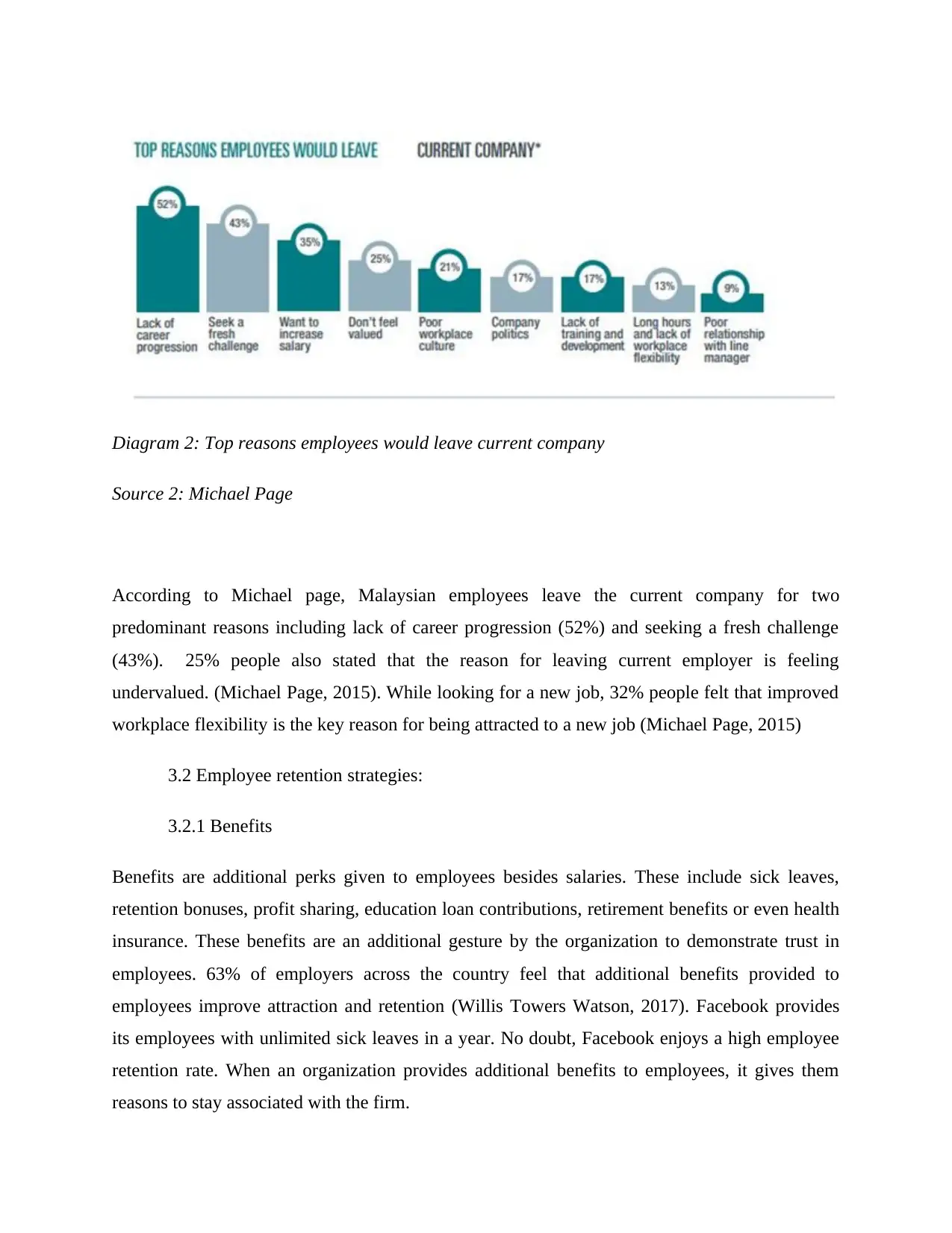
Diagram 2: Top reasons employees would leave current company
Source 2: Michael Page
According to Michael page, Malaysian employees leave the current company for two
predominant reasons including lack of career progression (52%) and seeking a fresh challenge
(43%). 25% people also stated that the reason for leaving current employer is feeling
undervalued. (Michael Page, 2015). While looking for a new job, 32% people felt that improved
workplace flexibility is the key reason for being attracted to a new job (Michael Page, 2015)
3.2 Employee retention strategies:
3.2.1 Benefits
Benefits are additional perks given to employees besides salaries. These include sick leaves,
retention bonuses, profit sharing, education loan contributions, retirement benefits or even health
insurance. These benefits are an additional gesture by the organization to demonstrate trust in
employees. 63% of employers across the country feel that additional benefits provided to
employees improve attraction and retention (Willis Towers Watson, 2017). Facebook provides
its employees with unlimited sick leaves in a year. No doubt, Facebook enjoys a high employee
retention rate. When an organization provides additional benefits to employees, it gives them
reasons to stay associated with the firm.
Source 2: Michael Page
According to Michael page, Malaysian employees leave the current company for two
predominant reasons including lack of career progression (52%) and seeking a fresh challenge
(43%). 25% people also stated that the reason for leaving current employer is feeling
undervalued. (Michael Page, 2015). While looking for a new job, 32% people felt that improved
workplace flexibility is the key reason for being attracted to a new job (Michael Page, 2015)
3.2 Employee retention strategies:
3.2.1 Benefits
Benefits are additional perks given to employees besides salaries. These include sick leaves,
retention bonuses, profit sharing, education loan contributions, retirement benefits or even health
insurance. These benefits are an additional gesture by the organization to demonstrate trust in
employees. 63% of employers across the country feel that additional benefits provided to
employees improve attraction and retention (Willis Towers Watson, 2017). Facebook provides
its employees with unlimited sick leaves in a year. No doubt, Facebook enjoys a high employee
retention rate. When an organization provides additional benefits to employees, it gives them
reasons to stay associated with the firm.

3.2.2 Employee engagement
Employee engagement has emerged as the main driver for organizational success. And
organizations are increasingly recognizing its importance in organizational success (Sharma &
Rajput, 2017). Employee engagement refers to the ability of the business to keep employees
engaged. The top three engagement drivers specifically for Malaysian organization are
empowerment, goals and objectives, and workload and work life (Willis Towers Watson, 2015).
Enhancing employee engagement would result in increased sense of ownership and hence
increased retention.
3.2.3 Working hours
The number of hours that an employee contributes to work largely impacts satisfaction as well as
work-life balance of the employee. In order to retain employees, it is imperative that
organizations must put efforts in improving employee’s work-life balance. Banking sector in
Malaysia specifically believes that offering flexible working hours to employees is a key strategy
for ensuring employee retention (Idris, 2014).
3.2.4 Rewards and recognition
Rewarding employees and recognizing hard work is an important strategy to keep employees
motivated within the firm (Cherry, 2016). Rewards can be monetary or non-monetary in the form
of cash prizes, paid vacations, promotions or improved jobs. Rewarding employees and
recognizing hard work will lead to improved retention since employees will feel more valued.
3.2.5 Learning and Growth
Employee learning plays a vital role in ensuring employee retention in the business. If employees
can feel themselves growing in a particular organization then employees will tend to remain
associated with the organization for a longer time.
3.3 Talent management
Talent management refers to the process of anticipating the need of human resources in the
business and building strategies to fulfill the same (Taylor, 2014). Talent management involves
Employee engagement has emerged as the main driver for organizational success. And
organizations are increasingly recognizing its importance in organizational success (Sharma &
Rajput, 2017). Employee engagement refers to the ability of the business to keep employees
engaged. The top three engagement drivers specifically for Malaysian organization are
empowerment, goals and objectives, and workload and work life (Willis Towers Watson, 2015).
Enhancing employee engagement would result in increased sense of ownership and hence
increased retention.
3.2.3 Working hours
The number of hours that an employee contributes to work largely impacts satisfaction as well as
work-life balance of the employee. In order to retain employees, it is imperative that
organizations must put efforts in improving employee’s work-life balance. Banking sector in
Malaysia specifically believes that offering flexible working hours to employees is a key strategy
for ensuring employee retention (Idris, 2014).
3.2.4 Rewards and recognition
Rewarding employees and recognizing hard work is an important strategy to keep employees
motivated within the firm (Cherry, 2016). Rewards can be monetary or non-monetary in the form
of cash prizes, paid vacations, promotions or improved jobs. Rewarding employees and
recognizing hard work will lead to improved retention since employees will feel more valued.
3.2.5 Learning and Growth
Employee learning plays a vital role in ensuring employee retention in the business. If employees
can feel themselves growing in a particular organization then employees will tend to remain
associated with the organization for a longer time.
3.3 Talent management
Talent management refers to the process of anticipating the need of human resources in the
business and building strategies to fulfill the same (Taylor, 2014). Talent management involves
⊘ This is a preview!⊘
Do you want full access?
Subscribe today to unlock all pages.

Trusted by 1+ million students worldwide
1 out of 18
Related Documents
Your All-in-One AI-Powered Toolkit for Academic Success.
+13062052269
info@desklib.com
Available 24*7 on WhatsApp / Email
![[object Object]](/_next/static/media/star-bottom.7253800d.svg)
Unlock your academic potential
Copyright © 2020–2025 A2Z Services. All Rights Reserved. Developed and managed by ZUCOL.





